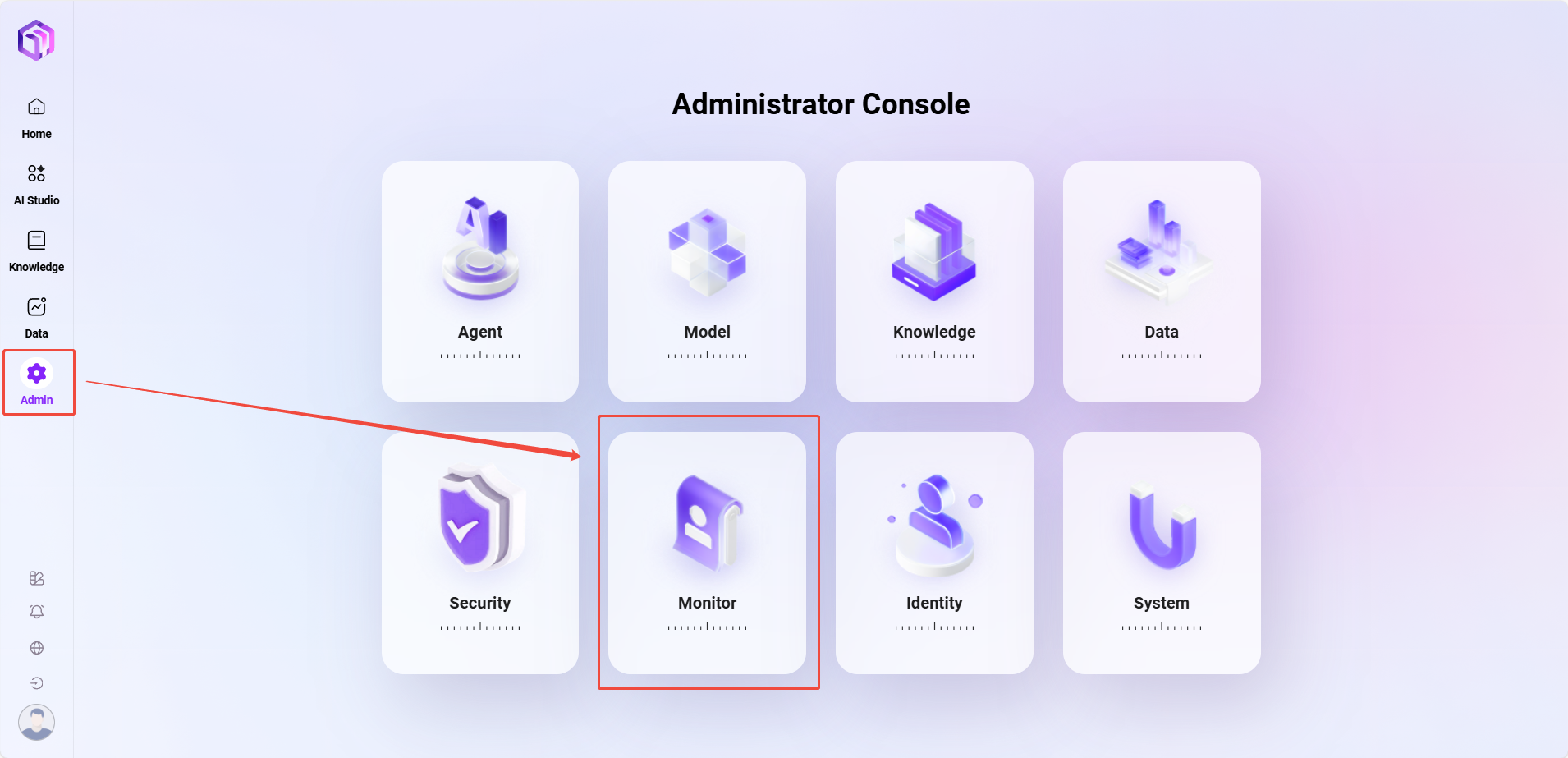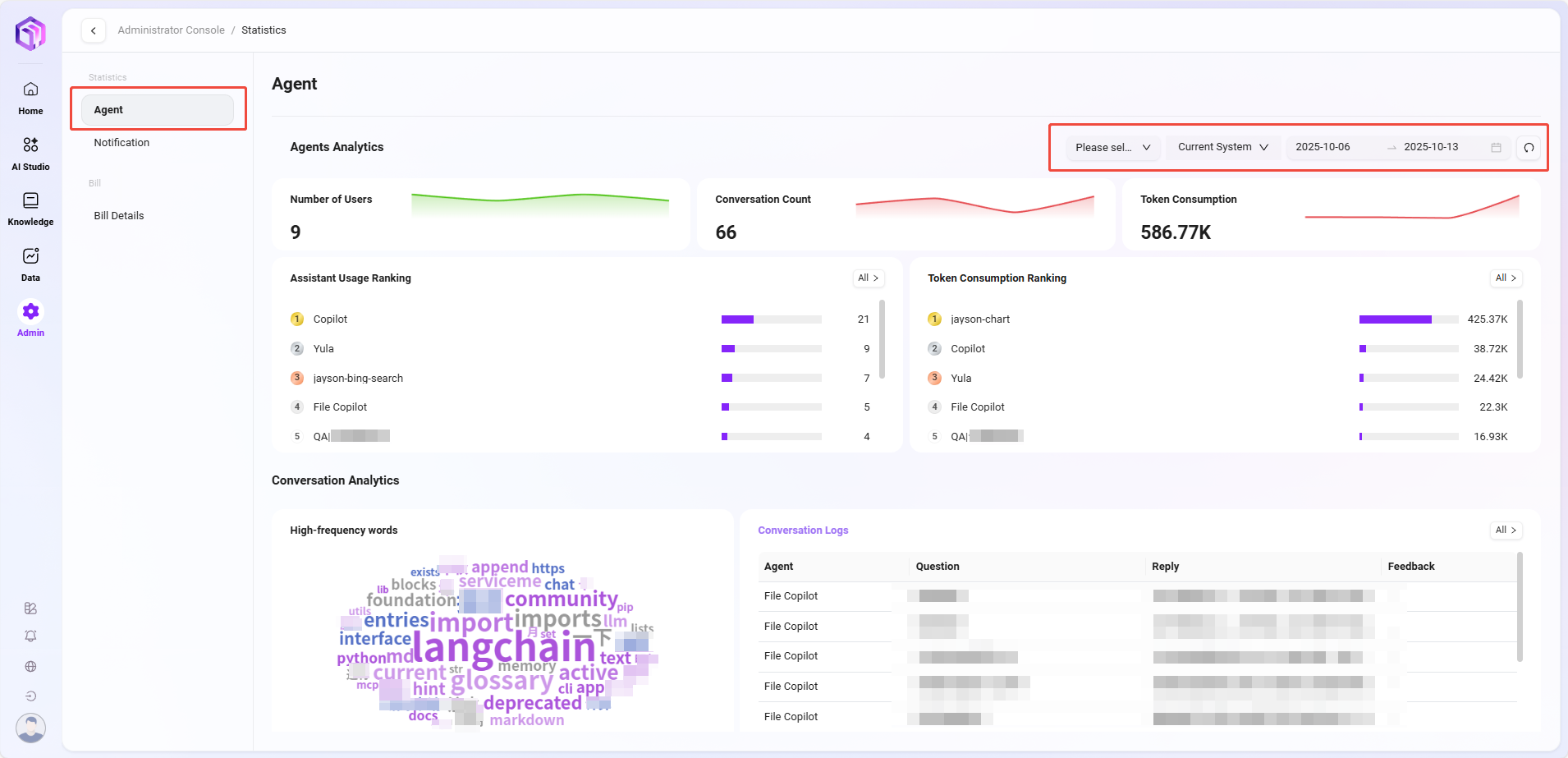Monitoring
The entry point for monitoring is as follows:

Statistics
Agent Monitoring
The Data Center provides comprehensive statistics and analysis on the usage of intelligent assistants and user conversation content, helping users better understand the effectiveness and operational status of AI, and optimize management and decision-making.
The Data Center supports data statistics by assistant dimension, system API dimension, and time dimension.
Assistant Analysis
This section focuses on quantitative analysis of the usage of each AI assistant, including:
- Number of users in conversation: The number of unique users who have interacted with the assistant.
- Number of conversations: The total number of interactions between users and the assistant, measuring usage activity.
- Token consumption: Measures the resource consumption of model calls during assistant operation.
- Assistant usage ranking: Ranks all assistants by usage frequency to identify high-frequency assistants.
- Token consumption ranking: Statistics on token usage by each assistant, assisting in resource optimization and cost control.
Conversation Analysis
This section delves into the content of conversations between users and assistants, providing insights into user needs and interaction patterns, including:
- High-frequency word analysis: Extracts keywords from user conversations to identify hot topics and demand trends.
- Conversation logs: View historical conversation details for quality review, troubleshooting, and content auditing.
💡 Tip: The statistics for the number of conversations and assistant usage ranking are updated once per day; other information such as conversation logs is updated in real time.

Notification Management
Notification management is used to count and view all types of notification messages received by all users in the system. Through this feature, administrators can track the delivery of notifications, understand whether users have read them, and whether the notification content has been effectively communicated.
For example: When a user provides feedback on an assistant's response during a conversation, the system will send a feedback notification to that user. Such notifications will be recorded and displayed in notification management.
Feature Description
On the notification management page, you can view the following information:
- Recipient: The account or username of the user who received the notification.
- Notification status: Whether the notification has been read (read / unread).
- Send time: The specific time when the system sent the notification.
- Notification content: Detailed information of the notification, supporting viewing of original prompts, feedback results, etc.
- Notification category: The category to which the notification belongs, such as feedback notification, system notification, task reminder, etc.
💡 Tip: Notifications can be filtered by time dimension.

System Logs
This system provides comprehensive log recording and analysis functions, covering three core log types: operation, event, and login logs, helping you achieve system behavior tracking, security auditing, and anomaly troubleshooting.
Operation Logs
Operation logs are used to record key operational behaviors of all users in the system, helping administrators track resource change history, audit system usage, and troubleshoot potential issues.
The system automatically captures every operation such as resource creation, update, publishing, or deletion, ensuring traceability and security of operations.
Field Description
| Field Name | Description |
|---|---|
| Operation ID | System-generated unique identifier to distinguish each operation record. |
| Username | The account name of the user performing the operation. |
| Operation Type | Indicates the source type of the operation, e.g., Robot, System, Manual, etc. |
| Resource Type | The resource category of the operated object, such as LiteRobot, DataSet, etc. |
| Resource Unique ID | The unique ID of the corresponding resource for precise object location. |
| Action Type | Indicates the type of operation performed, such as Create, Update, Publish, Publicize, etc. |
| Creation Time | The specific timestamp when the operation occurred, used for auditing and time sorting. |

Event Logs
Event logs are used to record various important events generated during the internal operation of the system, such as scheduled task execution, status changes, error alerts, etc. They are important tools for monitoring system health and troubleshooting internal issues.
Field Description
| Field Name | Field Function |
|---|---|
| Unique Event ID | System-generated unique identifier to distinguish each event record |
| Event Name | Brief description of the event content for quick understanding of the event nature |
| Event Occurrence Time | Records the specific timestamp when the event occurred, used for time sorting and analysis |
| Event Type | Identifies the event category (security, system, application, etc.), supports category filtering |
| Event Trigger Type | Records the triggering component or module of the event for easier troubleshooting |
| Event Description | View specific operation content |

Login Logs
Login logs comprehensively record all user authentication behaviors and are fundamental for security auditing and identifying abnormal logins.
Field Description
| Field Name | Field Function |
|---|---|
| Login Username | Records the account name of the login attempt, supports user behavior analysis |
| Login Time | Records the specific time of login, used for time series analysis |
| Login IP Address | Records the network address of the login source, supports geographic analysis and anomaly detection |
| Login Method | Identifies the authentication method (password, single sign-on, etc.), supports security policy analysis |

Notification Management
Notification management is used to count and view all types of notification messages received by all users in the system. Through this feature, administrators can track the delivery of notifications, understand whether users have read them, and whether the notification content has been effectively communicated.
For example: When a user provides feedback on an assistant's response during a conversation, the system will send a feedback notification to that user. Such notifications will be recorded and displayed in notification management.
Feature Description
On the notification management page, you can view the following information:
- Recipient: The account or username of the user who received the notification.
- Notification status: Whether the notification has been read (read / unread).
- Send time: The specific time when the system sent the notification.
- Notification content: Detailed information of the notification, supporting viewing of original prompts, feedback results, etc.
- Notification category: The category to which the notification belongs, such as feedback notification, system notification, task reminder, etc.
💡 Tip: Notifications can be filtered by time dimension.

Billing Details
In the SERVICEME system, you can view billing details for token usage. The line chart at the top of the interface displays the changes in token-related values at different time points, providing an intuitive view of usage trends. The table below records in detail the token consumption and corresponding costs of various models within a specific time period, and lists related usage types and other information, making it easy to clearly understand the billing situation for each token usage.
Information Provided on the Billing Details Page
On the billing details page, you can view the following information:
- Model Group: Displays the group category to which the model belongs.
- Model Set: Indicates the name of the collection to which the model belongs.
- Model: Shows the specific model name used.
- Channel: Identifies the channel through which the model is run.
- API Key Name: Displays the API key name used to access the model.
- Input Token: Records the number of tokens input into the model.
- Input token (cache hit): Shows the number of input tokens when the cache is hit.
- Output token: Displays the number of tokens consumed by the model's output.
- Token cost: Lists the cost incurred by using tokens.
- Time: Records the specific time when the model operation occurred.
- Operation: Provides executable options such as viewing log details.

Purpose of Billing Details
- Cost transparency: Accurately track the cost generated by each model call, achieving cost visibility, management, and control.
- Usage trend analysis: Identify resource consumption patterns through trend charts, providing data support for resource procurement and budget planning.
- Troubleshooting and optimization: Analyze the reasons for high-cost requests using detailed logs, and optimize prompts or business processes to control costs.
- Multi-dimensional allocation: Allocate costs to different projects or departments through dimensions such as model, channel, and API Key.